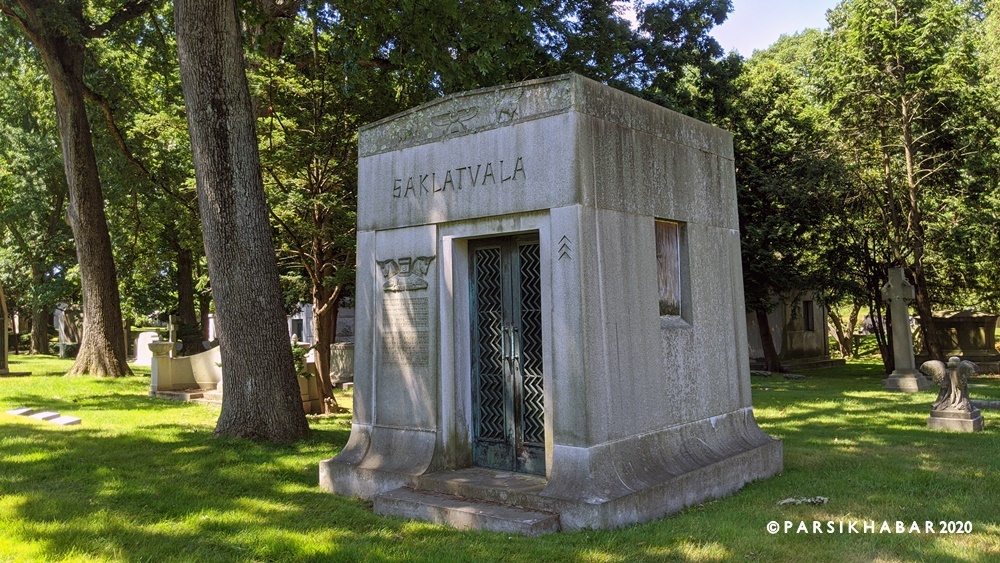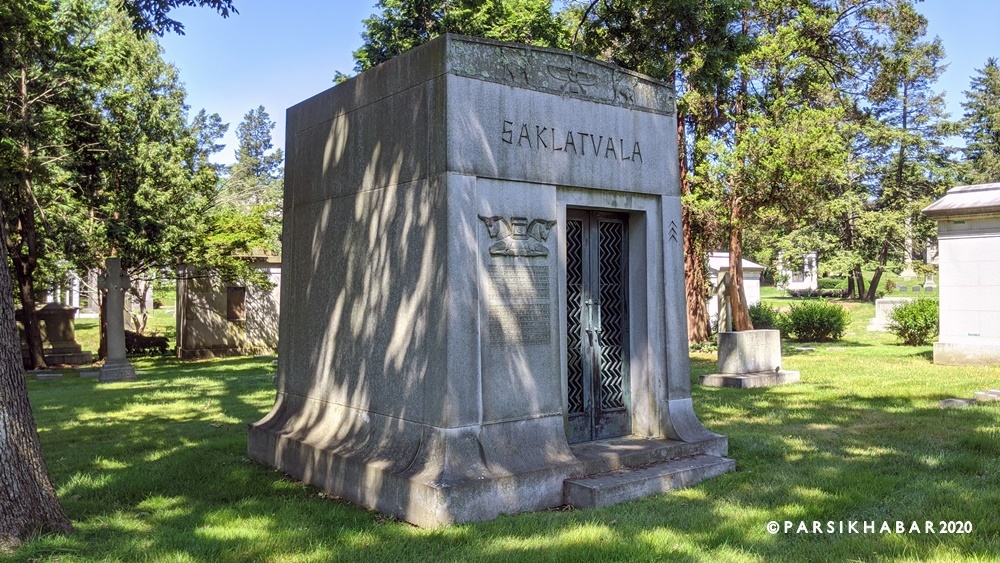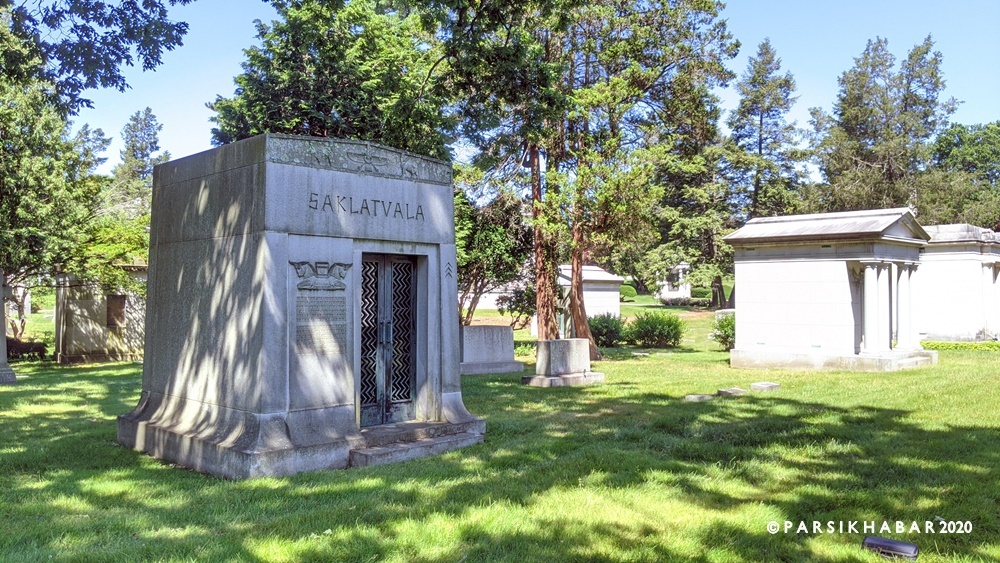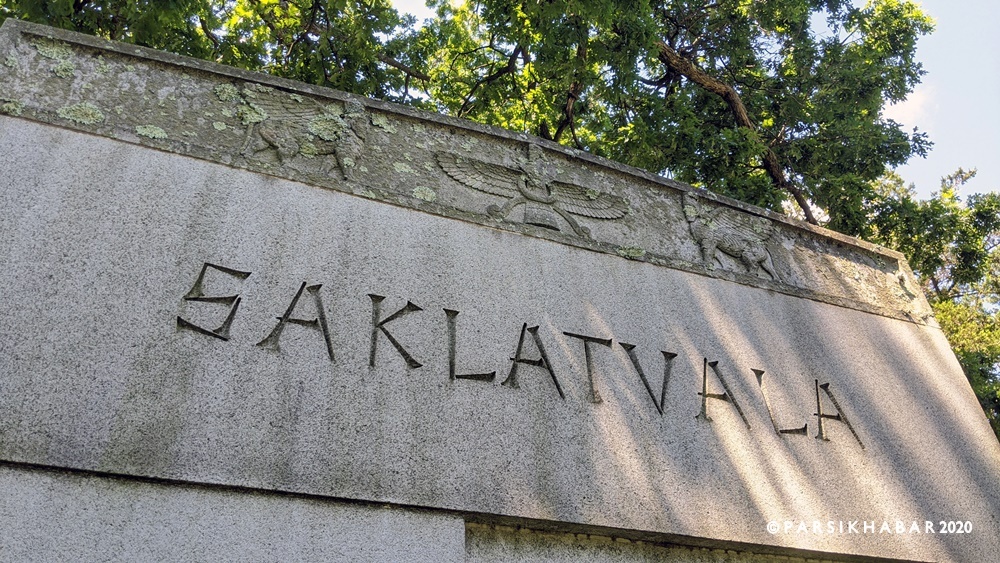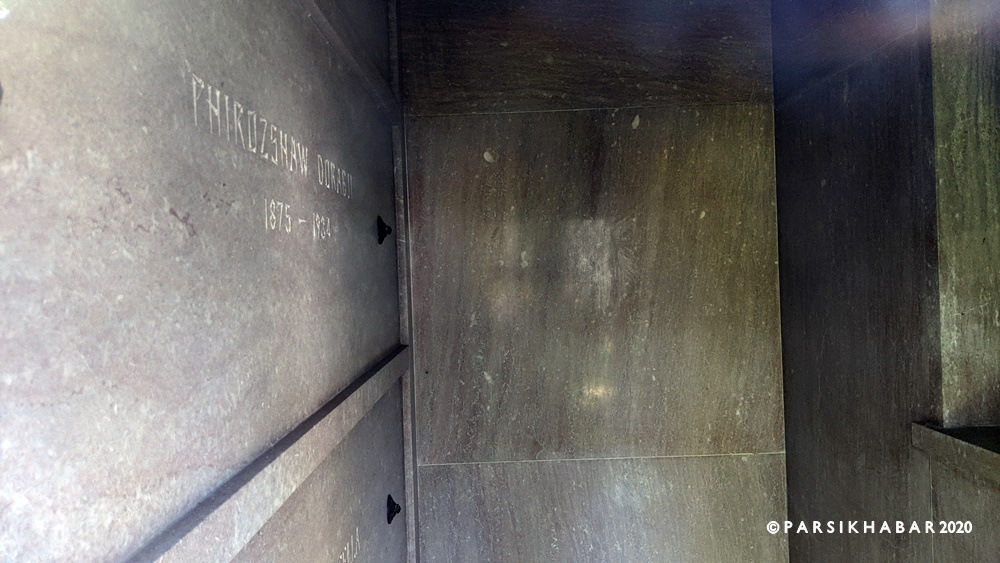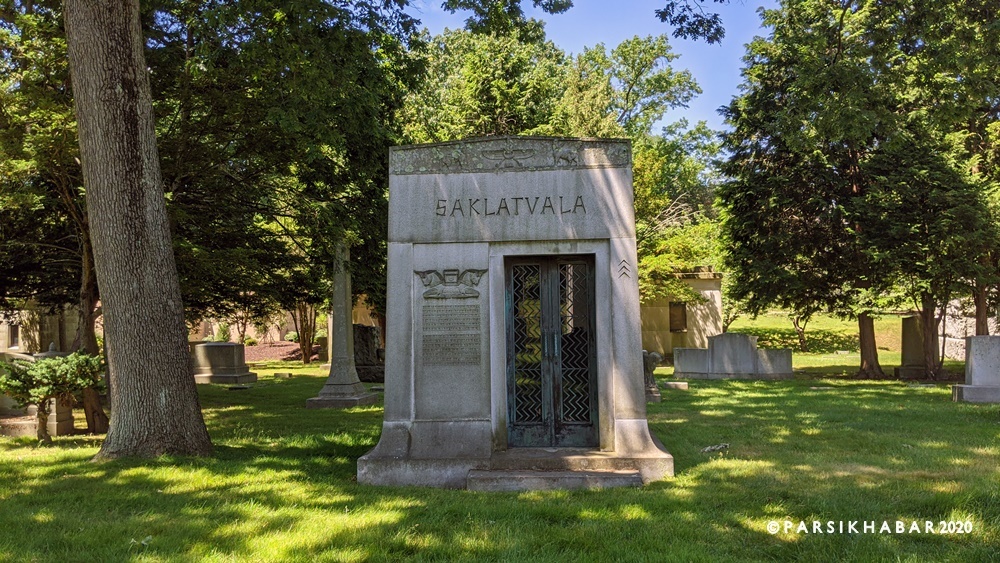An email from my friend Kersi Shroff tipped me off on what turned out to be a great treasure hunt in search of the Saklatvala Mausoleum in the Woodlawn Cemetery in the Bronx in New York City.
Kersi writes…
The Woodlawn Cemetery has cuneiform inscription on the tomb of the then well-known Phirozshah Saklatvalla, whose mother was the sister of Jamshedi Nusserwanji Tata. Phirozshah became a U.S. Citizen in 1904, making him one of the earliest non-whites to be granted citizenship. Prof. John Hinnells has written that Phirozshah formed the very first Parsi association in the U.S. in1929.
His tomb bears some interesting inscriptions in cuneiform which are worth exploring.
Part of the cuneiform inscription is stated to read:
The law of Ahuramazda–that I obey by the favor of Ahuramazda. If I do not leave the right path, may Ahuramazda protect me and my family. This I pray as a (mark of) favor.
The article co-authored by Mathew Stolper of the Oriental Institute, Chicago, in 2016, provides a good deal of information on Saklatvala and his family.
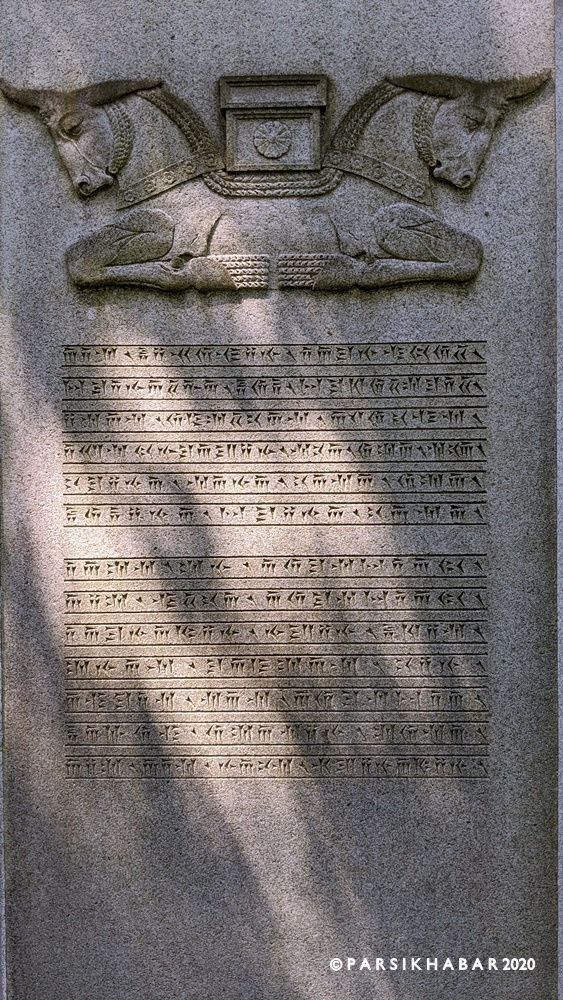
An Old Persian Cuneiform Inscription on a Tomb in the Woodlawn Cemetery, New York City
By Schmitt, Rudiger; Stolper, Matthew W.
Inauthentic ancient inscriptions have been composed to serve assorted purposes from antiquity on, from the Cruciform Monument of Manishtushu through the Donation of Constantine into the present. Inauthentic texts in Old Persian cuneiform script and in more or less accurate Old Persian language are also attested. Because the corpus of Achaemenid royal inscriptions is so small, inauthentic texts have drawn attention and scrutiny since at least the late nineteenth century. The first comprehensive collection of such Old Persian artifacts sorted them into inauthentic inscriptions of Achaemenid date, forgeries, and modern imitations. (1) It strove to list all known examples with full philological and linguistic commentary, but the number of inauthentic inscriptions continues to grow.
Many of these texts are outright forgeries, composed to make inscribed objects appear authentic, that is, to create fakes that are valuable to the composer of the text or his client, to sellers and collectors. Other modern inscriptions in Old Persian script and/or language were written not to deceive, but to entertain or commemorate. The earliest example known so far is a limestone tablet, on one side of which the English artist and traveler Robert Ker Porter (1777-1842) engraved what he considered to be the ancient name of [TEXT NOT REPRODUCIBLE IN ASCII.] or Taht-i Gamsid (both written on the opposite face), i’-s-t-a-x-r “Istahr” (2) (actually written [??]-s-t-a-x-r). Roland Kent listed a “jesting composition” composed by F. H. Weissbach among spurious texts in his bibliography of Old Persian inscriptions. (3) Several other pieces of this kind were created by Reverend Ralph Norman Sharp (1896-1995), who for decades lived in Shiraz and dealt now and then with Old Persian texts. (4)
Another modern composition, presented and discussed here, is cut on the front of a tomb in the Myosotis section of the Woodlawn Cemetery in the Bronx, New York, built between 1922 and 1924 by the Presbrey-Leland Company for the family of Phirozshaw D. Saklatvala. (5) It is the first known such composition inscribed on a tomb, and the first noticed in America.
THE SAKLATVALA TOMB AND THE SAKLATVALA FAMILY
The Presbrey-Leland Company, now located in Valhalla, New York, had its primary offices in New York City when the tomb was undertaken in 1922. The specifications call for the building to be constructed of Dummerston, Vermont, granite, exposed surfaces of the interior to be lined with polished Pink Tennessee Marble, and four interior “catacombs,” chambers designed to hold the remains of four individuals, to be made of Bangor, Pennsylvania, slate. The exterior decoration was to follow full-sized plaster models provided, and the name SAKLATVALA was to be incised above the door. The blueprints show the letters of the name formed with cuneiform-like wedges, as they appear on the built facade. The specifications refer to inscription slabs to be put in front of the catacombs, presumably to identify the individual remains, but they mention no other inscription on the exterior and the blueprints show no inscription or area prepared for inscription on the facade.
The clients in the Presbrey-Leland Company’s records and the lot owners in the Woodlawn Cemetery’s records are Phirozshaw D. Saklatvala and his wife Mae B. Saklatvala. Their remains were placed in the tomb in 1934 and 1939, respectively. The other two catacombs were occupied by the remains of their infant daughter Jerbai Stella Saklatvala, born 1920 and deceased at the age of seven months, before the tomb was built, and the first to be interred, and the remains of Behram D. Saklatwalla, brother of P. D. Saklatvala, interred in 1944.
The father of the Saklatvala brothers, Dorabji (called Darayavahus, Darius, in the inscription), was a Bombay merchant (6) and their mother, also named Jerbai (called Zari in the inscription), was the sister of Jamsetji Nusserwanji Tata (1839-1904), the founder of the modern Tata industrial group. The Tatas and Saklatvalas were related by marriage in previous generations, and J. N. Tata took the Saklatvala family into his home and raised the Saklatvala children with his own.
Phirozshaw Dorabji Saklatvala (also referred to as Phiroz or Phiroze, called Piruji in the inscription), born in Bombay in 1875, came to the United States in 1904 to represent the interests of the Tata family. (7) He became a U.S. citizen in (1916). He was president of the Middle States Oil Corporation, acquiring the sobriquet “the Parsi Oil King.” He died in New York in 1934. His secretary, who became his wife (called Mai in the inscription), was born Mae Bradley, in Ohio in 1882 and died in 1939. (8)
His younger brother Behram Dorabji Saklatwalla (the first name sometimes spelled Beram or Byramji, the last name occasionally spelled Saklatvala) was born in 1881. He was “undoubtedly the brains of his generation,” (9) educated in metallurgical science in Bombay, Berlin, and London, before coming to the United States in 1908. He became an executive of the American Vanadium Company and later co-founded the Alloys Development Company in Pittsburgh, Pennsylvania. He received the Grasselli Medal of the Society of Chemical Industry in 1924 and gave the Richards Memorial Lecture at the Electrochemical Society in 1943. (10) He collected contemporary art, supported the Downtown Gallery in New York, and served as president of a short-lived quarterly magazine of contemporary art, Space, founded in 1930. (11) He died in the crash of TWA flight 8 in northern California on November 4, 1944. His wife, Ann R. Saklatwalla, born in Pennsylvania in 1901, died in California in 1958.
The older brother of the American Saklatvalas, Shapurji Dorabji Saklatvala (1874-1936), followed a different course. In the first years of the twentieth century he prospected for coal and iron in central India, then in 1905 moved to England for reasons of health, because of personal conflict and professional disagreements with his cousin Dorabji Tata, the eldest of the Tata sons, and because of nascent political differences with the Tata family. (12) After preparing briefly for the bar, he entered politics. He was the third Indian-born Member of Parliament, for Battersea North, first in the Labour caucus and then as a Communist, between 1922 and 1929. (13)
Jerbai, the mother of the Saklatvala brothers, died in New York in November, 1907, during a visit to her American sons. Her remains were returned to London and interred in the Zoroastrian section of the Brookwood Cemetery in Woking. (14) She was also commemorated with a seventeenth-century Japanese statue of a young girl placed in the garden of the estate that Phiroz Saklatvala bought in 1907, in Plainfield, New Jersey. (15)
Phiroz Saklatvala’s espousal of Zoroastrian identity, explicit in the text of his tomb inscription, is reflected in his sponsorship of the first North American Zoroastrian association, organized at his New York City residence in November, 1929. (16) His espousal of Iranian affiliation, manifest in the decoration of the tomb and the language, script, and form of the inscription, is reflected in his pamphlet promoting the resources and commercial opportunities of contemporary Iran, (17) in his appointment as Honorary Consul-General for Iran after 1931, and in his advocacy of Iranian culture.
Phiroz Saklatvala supported the commemoration of the thousandth anniversary of the birth of Firdausi held at Columbia University on November 8, 1934, only weeks before his death. The publication of the speeches given at the occasion together with a catalog of the exhibition of manuscripts is dedicated to his memory. (18) Among the speakers at the event was Abraham Valentine Williams Jackson (1862-1937), whom the publication identifies as “Professor Emeritus in Residence of Indo-Iranian Languages, Trustee of the American School (sic) of Oriental Research, Honorary President of the American Institute of Persian Art and Archaeology, Director of the American Oriental Society, and author and translator of various works relating to Iranic literature.” (19)
THE OLD PERSIAN INSCRIPTION
General Epigraphic Observations
The Old Persian cuneiform text is carved in a niche to the left of the entrance to the tomb under the double-bull protome relief in Persepolitan style. The two paragraphs are separated by an empty space approximately as wide as a line of text.
The spacing of the sections resembles the layout of the final sections of the two greater Naqsh-i Rustam inscriptions DNa and DNb, which are also separated by a clear space. In each section of the Saklatvala tomb inscription the lines of text are laid out between top and bottom ruled lines, with space between the bottom ruling of one line and the top ruling of the next. This arrangement is unknown in the authentic Achaemenid inscriptions, suggesting that the model text prepared for the stone carver was composed on ruled paper with blank lines between the lines of text.
The engraving is careful and well-proportioned, but it immediately strikes the observer that every line ends with a word divider (in the form of a slanting wedge), even those lines that end the paragraphs. This is a sharp departure from the usage of authentic Old Persian inscriptions, which do not break lines at word divisions but run words across line-breaks. As a result, while authentic Old Persian inscriptions ordinarily have almost the same number of characters on every line of a text, in this inscription the number of characters per line varies within sections and between sections (18-23 signs per line, including word dividers, in the first section, only the last line of the section having fewer than 20 signs; 16-22 signs per line, including word dividers, in the second section, only the last, crowded, line of the section having more than 19 signs). This is the first instance of these traits among modern Old Persian texts.
Fig. 3a. First section (lines 1-6).
Transliteration
a-d-m : p-i-ru-u-ji-i-y : d-a-r-y-v-h-u-s :
z-r-i!-y-a-s-c-a : p-u-c : z-r-[theta]-u-s-t-r-i-s :
i-m-a-m : u-s-t-s-n-a-m : a-ku-u-n-v-m : 3
d-x-m-h-y-r-a-di-i-y : m-n-a : u-t-a : m-n-a :
n-r-i-y-a : m-a-y-a : n-a-m-a : u-t-a :
p-u-c-i-y-a : z-r-i-y-a : n-a-m-a : 6
Fig. 3b Second section (lines 7-13)
d-a-t-m : t-y : a-u-r-m-z-d-a-h : 7
a-i-t: v-s-n-a : a-u-r-m-z-d-a-h :
d-a-r-y-a-mi-i-y : y-di-i-y : p-[theta]-i-m :
t-y-a-m : r-a-s-t-a-m : n-i-y : 10
a-v-r-d-m : m-a-m : a-u-r-m-z-d-a :
p-a-tu-u-v : u-t-a-m-i-y : t-u-m-a<-m> :
a-i-t: a-d-m : y-a-n-m : j-di-i-y-a-mi-i-y : 13
A consistent peculiarity of the cuneiform characters in this inscription is in the form of sign y: its initial vertical stroke takes up only half the height of the line. This peculiarity is also found in the Old Persian version of Darius I’s great Blsutun inscription, whereas in all other (and later) Old Persian inscriptions the initial vertical of y fills the whole line. This difference in height had been observed already by Rawlinson, (20) but it had sunk into oblivion by the first half of the twentieth century.
The stone carver made two orthographic errors. In line 2, omitting one of two horizontal strokes, he wrote the character d for i, hence z-r-d-y-a-s-c-a instead of z-r-i-y-a-s-c-a. The corresponding form of the name in line 6 is written correctly. At the end of line 12 he omitted the final -m of the required accusative singular taumam.
Transcription 21
adam Piruji, Darayavahaus
Zariyas-ca puca, Zara[theta]ustris;
imam ustasanam akunavam 3
daxmahya-radi mana uta mana
nariya Maya nama uta
puciya Zariya nama. 6
datam taya A.uramazdaha– 7
aita vaSna A.uramazdaha
darayami; yadi pa[theta]im
tayam rastam nai 10
avaradam, mam A.uramazda
patu uta-maj taymam;
aita adam yanam jadiyami. 13
Translation
I (am) Piruji, the son of Darius (Dorab-ji) and Zari, a Zoroastrian. I built this monument as burial place for me and my wife by the name of Mae and (my/our) daughter by the name of Zari.
The law of Ahuramazda–that I obey by the favor of Ahuramazda. If I do not leave the right path, may Ahuramazda protect me and my family. This I pray as a (mark of) favor.
COMMENTS
The text takes the form of a “speaking inscription.” Large parts of it, especially of the second paragraph, are composed of word forms and phrases attested in authentic royal inscriptions, but words that do not occur in authentic inscriptions (like “wife” and “daughter”) had to be coined, and the personal names had to be rendered in a way considered appropriate.
Line1: Piruji: In modern English sources, P. D. Saklatvala’s first name is spelled in several ways. His own preference was apparently for the longer Phirozshaw (thus in the files of Woodlawn Cemetery and in the specifications concerning the construction of the mausoleum) and shorter Phiroz (thus in his booklet The Rich Fields in Persia and in the Firdausi Celebration volume).
This name Phiroz goes back to MPers. Peroz (“victorious,” the name of one Sasanian king), NPers. Piruz, Arabicized Firuz. Also common is the compound Peroz-sah or Firuzsah, (22) sah, (22) which lies behind the modern spelling Phiroz-shaw. Although Old Persian writing has distinct characters for p and f, the composer of the text chose the cuneiform spelling p-i-ru-ji-i-y with p-, not f-. Gujarati (which was certainly the Saklatvalas’ mother tongue) has no [f], but only the bilabial plosives [p] and [ph]. Hence, the English spellings of the name with Ph- do not point to [f] (as one might think a priori), but to [p(h)]. Furthermore, Gujarati has no [z], but normally renders NPers. z by [dz]. The honorific particle (Gujarati) -ji is added to most Parsi male names (but may often be omitted (23)). Hence p-i-ru-u-ji-i-y must be intended to render Piru-ji < *Piruj-ji, with a simplification of double -jj-.
Darayavahaus: The name of the Saklatvala brothers’ father, also the middle name of each brother, was Dorabji, otherwise commonly spelled Darabji. The element that precedes the honorific -ji is one of the manifold variants in which we find the OPers. royal name Darayava.u-, “Darius,” continued in New Persian: Dara, Daray, Darav, Darab. In the inscription, Dorab(-ji) is correctly transposed into Old Persian, “Achaemenidized” into the often attested genitive case form Darayavahaus.
Line 2: Zariyas-ca: This is the mother’s name, again in the genitive case connected with the father’s name by OPers. -ca “and.” The form *Zariyah (as attested also in line 6), belonging to an i-stem Zari-, appears here before -ca as Zariyos(-ca) with the same development of the cluster *-s-c- > -sc- seen in OPers. k-s-c-i-y /kas-ci/ “anyone” or m-n-s-c-a /manas-ca/ “thinking-and” (DNb 32). This Zari- interprets the name of Saklatvala’s mother Jerbai, more correctly Jarbai, one of the many Parsi female names ending in -bai (containing Gujarati bai, “mother”). Jar (-bai) is traditionally connected, as Modi (24) had already noted, with NPers. zar “gold.” Following this etymology, Zari- here takes the popular Persian hypocoristic name Zari “Goldie, Golda,” and adds anachronistic Old Persian inflection. (25)
Zaravustris: This form is a correct Avesticism, since nom. sing. YAv. zaravustris “Zoroastrian” is attested (e.g., in Yt. 13, 89) and known also from Aramaic zrtstrs on a fourth-century seal of unknown origin. (26) This and other traits noted below show strong Avestan influence on the composition, something new among modern Old Persian inscriptions.
Line 3: imam ustasanam: This phrase is quoted from [A.sup.3]Pa 29/22. In all four exemplars of that text, the demonstrative is spelled i-m-m, but rules of concord require the emendation i-m-<a>-m. Although editions up to and including Kent’s (27) did not make this emendation, the composer of the Saklatvala text wrote the word correctly.
Most surprising is the choice of the hapax ustasana- to refer to the tomb. Most scholars have understood and translated this word as “staircase” or the like, a meaning that is not at all appropriate to the structure of the Saklatvala monument. Ferdinand Justi proposed this interpretation, (28) which then was codified in Christian Bartholomae’s dictionary. (29) From the earliest times of philological commentary on [A.sup.3]Pa, however, scholars have debated the etymology and meaning of ustasana-, and the issue is not settled even today. (30) Other early interpretations include, e.g., “Hochbau” (building, structure), “Aufbau” (superstructure), and “Bauwerk” (building). (31) Later, Weissbach, whose compendium of the Achaemenid inscriptions was the most generally used reference before the publication of Kent’s Old Persian, preferred “Terrasse.” (32)
Line 4: daxmahya-radi: This sequence, in apparently irreproachable Old Persian, contains the genitive singular form of *daxma-, unattested in Old Persian, but a regular transposition of YAv. daxma- “burial place.” The genitive case depends on the postposition OPers. radi “on account of.” The joining of the two forms in a single compound follows the model attested only in OPers. avahya-radi “for that reason,” but not otherwise.
This use of -radi is revealing. In authentic Old Persian texts radi is always to be understood as causal, whereas the NPers. postposition ra, the regular continuant of Old Persian radi, serves many nuances of meaning. (33) Among others it is used in final sense, as radi is here, to denote purpose: “as/for a burial place.” Thus daxmahya-radi seems to be a loan translation after a New Persian model.
Line 5: nariya: Since no word for “wife” is attested in Old Persian, the composer of the inscription looked to OAv., YAv. nairi- “wife.” The correct Old Persian genitive-dative form would be *nariyah (= YAv. nairiio). The present “defective” spelling n-r-i-y-a lacks the long vowel in the root syllable (perhaps influenced by the short -a- in most case forms of the stem OAv., YAv. nar-, “man”).
Maya: The first name of Mae Bradley Saklatvala is suitably rendered. By analogy to the case form of Zariya (line 6) Maya is to be interpreted as a gen.-dat. form ending in oya to an i-stem *Mai- “Mae.”
Line 6: puciya: genitive-dative of *puci-, coined by the composer as a feminine counterpart of attested puca- “son.” It is striking that in the absence of an Avestan parallel *puvri-“daughter” (the cognate OLA putri- is attested only in Epic Sanskrit), the composer did not draw on the normal Avestan stem dug[??]dar-/du[gamma][delta]ar- “daughter.” The Old Persian cognate *duxsi, attested in the Achaemenid Elamite transcription duksis, “princess,” would not have been known before 1942. (34)
Lines 7-8: datam taya A.uramazdaha-aita… “the law of Ahuramazda–that…”, despite differences of lexicon and syntax, recalls DNa 56-57 haya A.uramazdaha framana –hauo … “The commandment of Ahuramazda–that…. ” Other allusions to DNa in the subsequent text imply that the author intended this resemblance.
Lines 9-10: pa[??]im tayam rastam “the right path” is attested in the same form as in DNa 58-59, depending there on the prohibitive ma avarada “do not leave!” which is echoed here in a first-person negative phrase nai avaradam with a syntactically remarkable injunctive.
Line l2: uta-mai taumam: This phrase (“and my family”), which must be in the accusative case (and therefore must be emended accordingly), is a variation of uta-mai vi{??]am “and my (royal) house,” a frequent element of the so-called “protection formula” (e.g., DNa 52-53). (35) One may compare similar variation between Darius’ haya amaxam tauma “our family” (DB I 8) and vi[??]am tayam amaxam “our (royal) house” (DB I 69, 71).
Line l3: aita adam yanam jadiyami: This sentence, (36) reflecting an expression of Old Iranian religious language, is a shortened quotation of DPd 20-21, where a second accusative of the deity beseeched (A.uramazdam) is added.
The date of the inscription and its authorship are uncertain. The file card with the cemetery’s record of the mausoleum’s maintenance includes four terse mentions of inscriptions, without indicating their placement: “Insc; … 1/1924” (soon after completion of the building), “Insc. (Dorabji) … 12/1934)” (immediately after Phiroz Saklatvala’s death, November 23, 1934, evidently referring to him by his patronym), “Inscription … 1/1939” (at the time of Mae Bradley Saklatvala’s death, January 6, 1939), and “Inscription … 9/30/54” (not quite ten years after the death of Behram Saklatvala on November 4, 1944, and his interment, according to another cemetery record, on December 4, 1944).
The use of the Old Persian word ustasana- to characterize the tomb building suggests that the composer of the text relied on sources from before about 1930. His implied rejection of both of the common translations, “staircase” and “terrace,” points to someone comfortable with the early philological scholarship of Old Persian, and his use of Avestan models points to someone widely familiar with Old Iranian. A. V. Williams Jackson, given his connection with the Parsis of India and New York in general and with the Saklatvalas in particular, is a plausible candidate for composer of the inscription if it was added to the tomb at or before Phiroz Saklatvala’s death. On the other hand, Jackson had seen the Achaemenid inscriptions at Bisutun and Persepolis, so the discrepancies between the layout of the Saklatvala tomb inscription and the layouts of authentic Old Persian royal inscriptions speaks against his candidacy.
Rudiger Schmitt
Saarland University, Saarbrucken
and
Matthew W. Stolper
The Oriental Institute, The University of Chicago
The introduction and text edition are chiefly by Schmitt, the description of the tomb and remarks on the family chiefly by Stolper, who also took the photographs. The authors share responsibility for ideas, opinions, and errors of substance or judgment. Achaemenid inscriptions are cited according to the system established by Roland G. Kent, Old Persian: Grammar, Texts, Lexicon, American Oriental Series, vol. 33, 2nd ed. (New Haven: American Oriental Society, 1953). Other abbreviations: MPers. = Middle Persian; NPers. = New Persian: OAv. = Old Avestan; OIA = Old Indo-Aryan; OPers. = Old Persian; YAv. = Young Avestan; Yt. = Yasht.
(1.) Rudiger Schmitt, Pseudo-altpersische Inschriflen: Inschriftenfalschungen und moderne Nachbildungen in altpersischer Keilschrift. Sitzungsberichte der Osterreichischen Akademie der Wissenschaften, phil.-hist. K1. 762 (Vienna: Verlag der Osterreichischen Akademie der Wissenschaften, 2007).
(2.) Lindsay Allen, The Persian Empire: A History (London: British Museum Press, 2005), 171 fig. 7.7; see Schmitt, Pseudo-altpersische Inschriften, 119-20, no. N1.
(3.) Kent, Old Persian, i 15. Spur, h; Schmitt. Pseudo-altpersische Inschriflen. 129-30, no. N10.
(4.) Schmitt. Pseudo-altpersische Inschriflen. 120-25, nos. N2, N3, N5, N6.
(5.) The firm’s blueprints and specifications and the cemetery’s records of inspections during construction and maintenance after completion are now housed in the Avery Architectural and Fine Arts Library at Columbia University. For generous help in locating and examining these records, we are indebted to Susan Olsen. Director of Historical Studies at the Woodlawn Cemetery, and to Janet Parks of the Avery Architectural and Fine Arts Library at Columbia. Thanks are due to Helen Rosner for drawing the tomb inscription to our attention, and to Dr. Kersey Antia and Roshan Rivetna for information and bibliographical assistance concerning the Saklatvalas.
(6.) Mike Squires, Saklatvala. a Political Biography (London: Lawrence and Wishart, 1990), 1. A newspaper repon of an interview quotes P. D. Saklatvala as saying that his father was a Parsi priest (Raymond G. Carroll, “Tells Ways of Parsees,” Moberly (Missouri) Evening Democrat, September 26, 1921: 2 (reprinted from the Philadelphia Public LedgerJ, http://www.newspapers.com/newspage/4688303/).
(7.) John R. Hinnells, The Zoroastrian Diaspora: Religion and Migration, Ratanbai Katrak Lectures, 1985 (Oxford: Oxford University Press, 2005), 449.
(8.) To her English niece, “Aunty Mae’s” ways and expectations as the widow of a rich man appeared glamorous, excessive, and embarrassingly rude (Sehri Saklatvala, The Fifth Commandment, a Biography of Sliapurji Saklatvala and Memoir by His Daughter [Miranda Press, 1991 = first digital edition 2012 http://uploads.worldlibrary.net/uploads/ pdf/20121012124550the_fifth_commandment_pdf.pdf). 507 = [Calcutta: National Book Agency, 1996), 417 [cited below according to the pagination of the digital edition, followed by the pagination of the 1996 reprint in parentheses)).
(9.) Saklatvala, The Fifth Commandment, 71 (55).
(10.) B. D. Saklatwalla, “Grasselli Medal Award: Fundamentalism in Ferrous Metallurgy.” Industrial and Engineering Chemistry 17 (1925): 96-98; “Eighth Joseph W. Richards Memorial Lecture: Thermal Reactions in Ferro-Alloy Metallurgy, the Basis of Alloy Steel Development,” Journal of the Electrochemical Society 84 (1943): 13ff.
(11.) Lindsay Pollock, The Girl with the Gallery: Edith Gregor Halpert and the Making of the Modern Art Market (New York: Public Affairs, 2006), 102, 107; Modern Paintings including Works by Utrillo, Sisley, Renoir, Cassatt, Matisse, Modigliani, Forain, Miro, Gris, Dali, Kuhn, Hartley, Weber from the Collection Formed by the Late Dr. B. D. Saklatwalla, Pittsburgh, PA Sold by Order of Mrs. Saklatwalla, Public Auction Sale, May 1, 1946 (New York: Parke-Bernet Galleries, 1946); “Oral History Interview with Edith Gregor Halpert, 1962-1963,” http://www. aaa.si.edu/collections/interviews/oral-history-interview-edith-gregor-halpert-13220.
(12.) In Shapurji Saklatvala’s view, according to a letter quoted at length in his daughter’s biography of him, the Tatas had dispossessed the Saklatvalas of their inheritance, raising the Saklatvala children as dependents and alienating them from their absent, ruined father (Saklatvala, The Fifth Commandment, 11-13 [4-5]).
(13.) Squires, Saklatvala, 6 and passim; Hinnells, The Zoroastrian Diaspora, 376-85.
(14.) Squires, Saklatvala, 9; Saklatvala, The Fifth Commandment, 55-56 (42); Hinnells, The Zoroastrian Diaspora, 350.
(15.) “Golestan in the Smithsonian Archives”: http://plainfieldgardenc!ub.org/cgi-bin/p/awtp- pa.cgi?d=plainfieldgardenclub&type=4776. Despite the Persian name “Golestan,” the garden was designed in Japanese style by Takeo Shiota (1883-1941), who designed the Japanese garden in the Brooklyn Botanical Garden in 1914. Among the films shot in part in the Golestan was a silent version of “Madame Butterfly” with Mary Pickford in the title role; a surviving photo shows her posing next to the statue that commemorates Jerbai Saklatvala (http://plainfieldgardenclub.org/ cgi-bin/p/awtp-showpic-pa.cgi?d=1754&s=46747).
(16.) Hinnells, The Zoroastrian Diaspora, 449-50; Jamshed Pavri, “The Pioneer Settlers,” FEZANA Journal 10/1 (1997): 26-27 (from remarks given in 1982).
(17.) Phiroz D. Saklatvala, The Rich Fields in Persia (Bombay: The Iran League, 1933), reprinted from Iran League Quarterly.
(18.) Firdausi Celebration, 935-1935, ed. David E. Smith (New York: McFarlane, Warde, McFarlane, 1936), v, ix. An article published in the Columbia Daily Spectator on the day before the event lists Honorary Consul Phiroz D. Saklatvala among the prominent personages expected to attend the commemoration, along with Governor Herbert H. Lehman, Mayor Fiorello H. LaGuardia, and Metropolitan Museum of Art Director Herbert E. Winlock (“Butler, Trustees to Honor Birth of Persian Epic Poet,” Columbia Daily Spectator 58/29, 7 November 1934: 4 (http://spectatorarchive.library.columbia.edu/cgi-bin/columbia?a=d&d=csl9341107-01.1.4&e——-en 20-1-txt-txIN——#). The preface to the publication of the event names P. D. Saklatvala’s wife and brother among financial supporters, as well as Mrs. W. H. Moore, the donor who supported the first years of the Oriental Institute’s excavations at Persepolis, 1931-34 (Smith, Firdausi Celebration, ix).
(19.) Smith, Firdausi Celebration, viii-ix. Another link between Saklatvala and Jackson is Dastur Maneckji Nuserwanji Dhalla (1875-1956), who took a Ph.D. at Columbia under Jackson in 1908 before becoming High Priest of the Parsis of Karachi. He returned to New York in 1929 to receive an honorary Litt. D. at Columbia’s 175th anniversary celebration, and he proposed the meeting at Saklatvala’s home at which the Zoroastrian Association was formed (Hinnells, The Zoroastrian Diaspora, 212-16, 450; Rustom D. Wadia, “The Shadow of Suicide,” Parsiana 14/4 (1991): 24-25, dates the event to June, 1927; in general: Kaikhusroo JamaspAsa, “Dhalla, Dastur Maneckji Nusserwanji,” Encyclopaedia Iranica VII/4 (1996), 355-56 (http://www.iranicaonline.org/articles/ dhalla); Maneckji Nusserwanji Dhalla, Dastur Dhalla, The Saga of a Soul, tr. Gool and Behram Sorab H. J. Rostamji (Karachi: Dastur Dr. Dhalla Memorial Institute, 1975).
(20.) H. C. Rawlinson, “The Persian Cuneiform Inscription at Behistun, Decyphered and Translated,” Journal of the Royal Asiatic Society 10 (1847): 136 n. 1.
(21.) In the style of, e.g., Rudiger Schmitt, Die altpersischen Inschriften der Achaimeniden: Editio minor mit deutscher Ubersetzung (Wiesbaden: Reichert Verlag, 2009).
(22.) See Ferdinand Justi, Iranisches Namenbuch (Marburg, 1895; rpt. Hildesheim: Georg Olms. 1963), 250b f. no. 8a-q.
(23.) Jivanji Jamshedji Modi, The Religious Ceremonies and Customs of the Parsees (Bombay: British India Press, 1922), 10-11.
(24.) Religious Ceremonies, 11. In the “almost complete list of names of Parsi men and women in general use at present” given by Dosabhai Framji Karaka. History of the Parsis including Their Manners. Customs, Religion, and Present Position (London: Macmillan, 1884), I. 162-63 n. 1, all the names of interest here are found, both “Firozji, or Firozsha, or Phirozsha” and Dorabji as well as Jarbai.
(25.) The inscription on the gravestone of Shapurji Saklatvala at the Brookside Cemetery in London, in plain English, gives the parents’ names as Dorabji and Jerbai Saklatvala (Saklatvala, The Fifth Commandment, 6 [1]).
(26.) Pierre Bordreuil, Catalogue des sceaux ouest-semitiques inscrits de la Bibliotheque Nationale, du Musee du Louvre et du Musee biblique de Bible et Terre Sainte (Paris: Bibliotheque Nationale, 1986), 104, no. 136, cited in passing by Mark Garrison (M. B. Garrison The Ritual Landscape at Persepolis: The Glyptic Imagery from the Persepolis Fortification and Treasury Archives, SOAC 72 [Chicago: Oriental Institute, 2017]). Garrison (p.c.) questions the authenticity of this unprovenanced seal, among other reasons because of the very large empty space, the oddly rendered winged symbol with three tendrils, and the inscription cut to be read correctly on the stone, not on the impression. Whoever transcribed the name into Aramaic script on the seal, however, whether ancient or modern, drew it from a correct Avestan form.
(27.) Old Persian, 156.
(28.) “Geschichte Irans von den altesten Zeiten bis zum Ausgang der Sasaniden,” in Grundriss der iranischen Philologie, ed. W. Geiger and E. Kuhn (Strassburg: Karl J. Trubner, 1896-1904), II 395-550, especially 452.
(29.) Altiranisches Worterbuch (Strassburg: Karl J. Trubner, 1904), 407; cf. Herbert Cushing Tolman, Ancient Persian Lexicon and the Texts of the Achaemenidan Inscriptions … (New York: American Book Company, 1908), 78; A. Meillet, Grammaire du vieux-perse. Deuxieme edition entierement corrigee et augmentee par E. Benveniste (Paris: Honore Champion, 1931), 155 [section] 265,169 [section] 294, 177 [section] 306; not yet, however, in the first edition (Paris: Librairie Orientale & Americaine, 1915) in the corresponding passages.
(30.) See Rudiger Schmitt, Beitrage zu altpersischen Inschriften (Wiesbaden: Reichert Verlag, 1999), 101; idem, Worterbuch der altpersischen Konigsinschriften (Wiesbaden: Reichert Verlag, 2014), 266.
(31.) Those proposals are by Friedrich Spiegel, Die altpersischen Keilinschriften (Leipzig: Wilhelm Engelmann, 1881), 71, 213; Willy Foy, “Beitrage zur erklarung der altpersischen keilinschriften,” Zeitschrift fur vergleichende Sprachforschung 35 (1899): 1-78, especially 57; and F. H. Weissbach and W. Bang, Die altpersischen Keilinschriften in Umschrift und Ubersetzung (Leipzig: J. C. Hinrichs’sche Buchhandlung, 1908 [that part of the booklet being published, however, already in 1893]), 47, respectively.
(32.) F. H. Weissbach, Die Keilinschriften der Achumeniden, Vorderasiatische Bibliothek 3 (Leipzig: J. C. Hinrichs’sche Buchhandlung, 1911), 129.
(33.) The functions of NPers. ra are described in full detail by Gilbert Lazard, La langue des plus anciens monuments de la prose persane (Paris: Librairie C. Klincksieck, 1963), 356-84.
(34.) George G. Cameron, “Darius’ Daughter and the Persepolis Inscriptions,” Journal of Near Eastern Studies 1 (1942): 217; Jan Tavernier, Iranica in the Achaemenid Period (ca. 550-330 B.C.), Orientalia Lovaniensia Analecta 158 (Leuven: Peeters, 2007), 420, with literature.
(35.) See Rudiger Schmitt, “Zum Schluss von Dareios’ Inschrift ‘Susa e’,” Archaeologische Mitteilungen aus Iran 25 (1992 [1993]): 147-54, especially 151-52.
(36.) Cf. Schmitt, Beitrage zu altpersischen Inschriften, 29-30.
COPYRIGHT 2016 American Oriental Society
“An old Persian cuneiform inscription on a tomb in the Woodlawn Cemetery, New York City..” The Free Library. 2016 American Oriental Society 31 Jul. 2020 https://www.thefreelibrary.com/An+old+Persian+cuneiform+inscription+on+a+tomb+in+the+Woodlawn…-a0473923109

